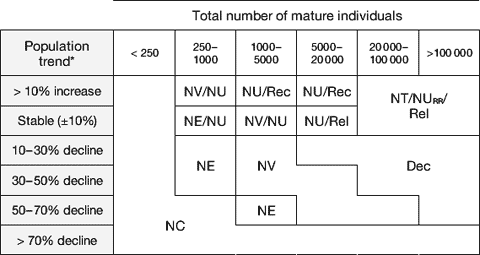Primary criteria
Nationally Critical
- Less than 250 mature individuals (natural or unnatural); or
- 250-1000 mature individuals and 50-70% decline over 10 years or 3 generations; or
- Any population size with a greater than 70% population decline over 10 years or 3 generations, whichever is longer.
Nationally Endangered
- 250-1000 mature individuals (natural or unnatural) with a 10-50% population decline; or
- 250-1000 mature individuals (unnatural) with a stable population; or
- 1000-5000 mature individuals with a 50-70% population decline.
Nationally Vulnerable
- 250-1000 mature individuals (unnatural) with a population increase of more than 10%; or
- 1000-5000 mature individuals (unnatural) with a stable population; or
- 1000-5000 mature individuals with a 10-50% population decline; or
- 5000-20,000 mature individuals with a 30-70% population decline; or
- 20,000-100,000 mature individuals with a 50-70% population decline.
Declining
- 5000-20,000 mature individuals with a 10-30% population decline; or
- 20,000-100,000 mature individuals with a 10-50% population decline; or
- >100,000 mature individuals with a 10-70% population decline.
Recovering
- 1000-20,000 mature individuals with a population increase of more than 10%
Relict
- 5000-20,000 mature individuals with a stable population; or
- More than 20,000 mature individuals with a stable or increasing population; or
- All Relict species occupy less than 10% of their original range.
Primary criteria table

* Predicted and ongoing due to existing threats
Abbreviations:
Dec = Declining
NC = Nationally Critical
NE = Nationally Endangered
NT = Not Threatened
NU = Naturally Uncommon
NV = Nationally Vulnerable
Rec = Recovering
Rel = Relict
RR = Range Restricted
Notes:
- Population changes are calculated over 10 years or three generations, whichever is longer.
- Where more than 1 option is available in a cell, the key distinction is whether the current population size level is considered natural, or results from human impacts.
- Naturally Uncommon (Range Restricted) is triggered when the breeding range is < 100,000 ha.
Secondary criteria
If population size is very difficult or impossible to estimate then secondary criteria (number of subpopulations or area occupied) can be used to help determine a species threat ranking.
Secondary criteria can be found on page 15 of New Zealand Threat Classification System manual, 2008.
References
Andrew J. Townsend, Peter J. de Lange, Clinton A.J. Duffy, Colin M. Miskelly, Janice Molloy and David A. Norton. 2008. New Zealand Threat Classification System manual, 2008.
Related
IUCN Red List of Threatened Species website
Threatened species management activity
Reports listing New Zealand native species that are classified in some way as threatened, and which had work targets – either active species management programmes or survey monitoring and research.
- 2014-15: Species management report (PDF, 180K) or (XLXS, 181K)
- 2013-14: Species management report (PDF, 185K) or (XLSX, 32K)